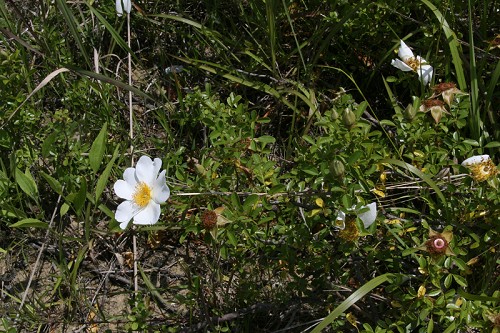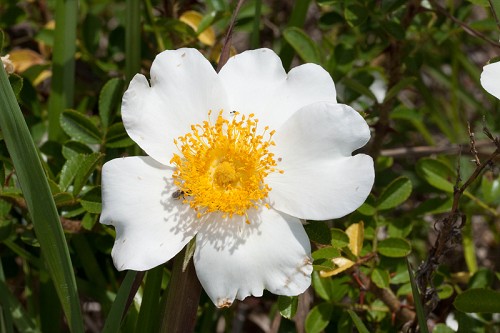Difference between revisions of "Rosa bracteata"
Krobertson (talk | contribs) |
HaleighJoM (talk | contribs) (→Ecology) |
||
| (3 intermediate revisions by 3 users not shown) | |||
| Line 18: | Line 18: | ||
}} | }} | ||
| − | Common | + | Common names: Macartney rose, Chickasaw Rose |
==Taxonomic notes== | ==Taxonomic notes== | ||
''Rosa bracteata'' was introduced to Europe in 1795, and later to the United States, where it became widely naturalized and invasive in parts of the southeast, and in the West Indies. [http://www.efloras.org/florataxon.aspx?flora_id=1&taxon_id=200011225 The Flora of North America]. | ''Rosa bracteata'' was introduced to Europe in 1795, and later to the United States, where it became widely naturalized and invasive in parts of the southeast, and in the West Indies. [http://www.efloras.org/florataxon.aspx?flora_id=1&taxon_id=200011225 The Flora of North America]. | ||
| Line 28: | Line 28: | ||
==Distribution== | ==Distribution== | ||
==Ecology== | ==Ecology== | ||
| − | ===Habitat=== <!--Natural communities, human disturbed habitats, topography, hydrology, soils, light, fire regime requirements for removal of competition, etc.--> | + | <!--===Habitat=== <!--Natural communities, human disturbed habitats, topography, hydrology, soils, light, fire regime requirements for removal of competition, etc.--> |
===Phenology=== <!--Timing off flowering, fruiting, seed dispersal, and environmental triggers. Cite PanFlora website if appropriate: http://www.gilnelson.com/PanFlora/ --> | ===Phenology=== <!--Timing off flowering, fruiting, seed dispersal, and environmental triggers. Cite PanFlora website if appropriate: http://www.gilnelson.com/PanFlora/ --> | ||
| − | ===Seed dispersal=== | + | It has been observed flowering from May to July.<ref>Nelson, G. [http://www.gilnelson.com/ PanFlora]: Plant data for the eastern United States with emphasis on the Southeastern Coastal Plains, Florida, and the Florida Panhandle. www.gilnelson.com/PanFlora/ Accessed: 13 DEC 2016</ref> |
| − | ===Seed bank and germination=== | + | <!--===Seed dispersal===--> |
| − | ===Fire ecology=== <!--Fire tolerance, fire dependence, adaptive fire responses--> | + | <!--===Seed bank and germination===--> |
| + | <!--===Fire ecology=== <!--Fire tolerance, fire dependence, adaptive fire responses--> | ||
===Pollination=== | ===Pollination=== | ||
The following Hymenoptera families and species were observed visiting flowers of ''Rosa bracteata'' at Archbold Biological Station:<ref name="Deyrup 2015">Deyrup, M.A. and N.D. 2015. Database of observations of Hymenoptera visitations to flowers of plants on Archbold Biological Station, Florida, USA.</ref> | The following Hymenoptera families and species were observed visiting flowers of ''Rosa bracteata'' at Archbold Biological Station:<ref name="Deyrup 2015">Deyrup, M.A. and N.D. 2015. Database of observations of Hymenoptera visitations to flowers of plants on Archbold Biological Station, Florida, USA.</ref> | ||
| Line 39: | Line 40: | ||
Halictidae: ''Halictus poeyi, Lasioglossum coreopsis'' | Halictidae: ''Halictus poeyi, Lasioglossum coreopsis'' | ||
| + | <!--===Herbivory and toxicology===<!--Common herbivores, granivory, insect hosting, poisonous chemicals, allelopathy, etc--> | ||
| + | <!--===Diseases and parasites===--> | ||
| − | == | + | ==Conservation, cultivation, and restoration== |
| − | + | ||
| − | + | ==Cultural use== | |
| − | == | ||
==Photo Gallery== | ==Photo Gallery== | ||
<gallery widths=180px> | <gallery widths=180px> | ||
Latest revision as of 15:25, 15 July 2022
| Rosa bracteata | |
|---|---|

| |
| Photo by John R. Gwaltney, Southeastern Flora.com | |
| Scientific classification | |
| Kingdom: | Plantae |
| Division: | Magnoliophyta - Flowering plants |
| Class: | Magnoliopsida – Dicotyledons |
| Order: | Rosales |
| Family: | Rosaceae |
| Genus: | Rosa |
| Species: | R. bracteata |
| Binomial name | |
| Rosa bracteata J.C. Wendl. | |

| |
| Natural range of Rosa bracteata from USDA NRCS Plants Database. | |
Common names: Macartney rose, Chickasaw Rose
Contents
Taxonomic notes
Rosa bracteata was introduced to Europe in 1795, and later to the United States, where it became widely naturalized and invasive in parts of the southeast, and in the West Indies. The Flora of North America.
Description
A description of Rosa bracteata is provided in The Flora of North America.
Distribution
Ecology
Phenology
It has been observed flowering from May to July.[1]
Pollination
The following Hymenoptera families and species were observed visiting flowers of Rosa bracteata at Archbold Biological Station:[2]
Apidae: Bombus pennsylvanicus
Halictidae: Halictus poeyi, Lasioglossum coreopsis
Conservation, cultivation, and restoration
Cultural use
Photo Gallery
Flower of Rosa bracteata Photo by John R. Gwaltney, Southeastern Flora.com
References and notes
- ↑ Nelson, G. PanFlora: Plant data for the eastern United States with emphasis on the Southeastern Coastal Plains, Florida, and the Florida Panhandle. www.gilnelson.com/PanFlora/ Accessed: 13 DEC 2016
- ↑ Deyrup, M.A. and N.D. 2015. Database of observations of Hymenoptera visitations to flowers of plants on Archbold Biological Station, Florida, USA.
